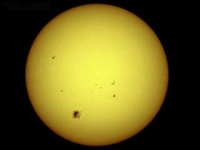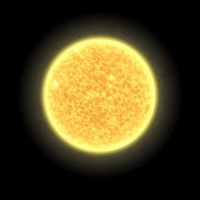Sol (star)
| Sol | |

| |
| Spectral | G2 V |
| Type | Main Sequence |
| Luminosity | 1 LSol |
| Absolute magnitude | 4.83 |
| Mag Terra | −26.74 (0th) |
| Temperature | 5,778° K |
| Mass | 1 MSol |
| Radius | 1 RSol |
Sol is the solitary yellowish-white primary star of the Terran system, and gives its name to Sol Subsector of Solomani Rim Sector.
Description (Specifications)[edit]
Sol is an unremarkable G2 V yellow-white main sequence Population I star that lies approximately 8150 pc from the center of Galaxias on the inner edge of one of the spiral-shaped concentrations of gas and dust called the "Local Arm" (or occasionally the "Orion-Cygnus Spur" of the Sagittarius-Carina Arm), about 6pc North of the mean galactic plane. [1]
- Sol has an effective stellar temperature of 5,800° K.
- The Sol star system lies at the Origin of the old Solomani Galactic Coordinate System.
Terra (SR 1827) has a solitary primary star. Sol 
Type Category Mass (Sol) Temperature (K) Luminosity G2 V Main Sequence (Dwarf) 1 5720 - 5770 1 Unit Diameter Safe Distance Habitable Zone Jump Shadow M-Drive Limit AU 0.0094 0.0829 0.95 - 1.68 0.94 9.4 Orbit # * * 4 3 7 Remarks "The Sun"
History & Background (Dossier)[edit]
Sol is the primary star of the world Terra/Sol (Solomani Rim 1827).
Image Repository[edit]
TravellerMap (T5SS):
[1]
Because of the Terran influence during the Rule of Man, Sol is used in the Imperial and Solomani scientific systems as the basis for defining stellar mass, radius and luminosity; Sol has a value of 1 in each of these figures.
References & Contributors (Sources)[edit]
| This article has metadata. |
| This page uses content from Wikipedia. The original article was at Sun. The list of authors can be seen in the page history. The text of Wikipedia is available under the Commons Attribution-ShareAlike 3.0 Unported License. |
- GURPS Traveller: Rim of Fire
- Mongoose Traveller: Solomani Rim
- EXTERNAL LINK: "Scientific American" [2]. "New View of the Milky Way" (April 2020). p. 35
- Traveller Wiki Editorial Team
- Author & Contributor: Lord & Chief Marshall (Count) Dan Corrin of the Office of the Emperor
- Author & Contributor: Garnfellow
- Author & Contributor: WHULorigan
- Author & Contributor: Lord (Marquis) and Master of Sophontology Maksim-Smelchak of the Ministry of Science
- ↑ Anonymous published Scientific American (April 2020), p.35